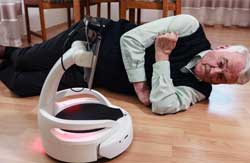The mobile emergency assistant from Fraunhofer IPA is getting ready for market

In the event of a fall, MobiNa autonomously makes its way to the person in need.<br>Fraunhofer IPA <br>
At REHACARE 2012, Fraunhofer Institute for Manufacturing Engineering and Automation unveiled a pioneering mobile emergency assistance system that combines an independently navigating, interactive service robot with a stationary sensor system designed to deliver external support to elderly and infirm persons to enable them to live longer in their own homes and with an improved quality of life.
In the meantime, researchers at Fraunhofer have made significant advances in readying the system for market: “MobiNa” has been made smaller and more manoeuvrable and serves its owner not only as a dependable helper in emergency situations, but also as a continuously available mobile communication system – on a robust and simple platform that can be reproduced at low cost.
“MobiNa is a mobile communication system in the same price class as a high-grade consumer electronics product or good robotic vacuum cleaner. In other words, it has been designed to be affordable for anyone who needs it,” says Dr. Birgit Graf, Group Manager for Domestic and Personal Robotics at Fraunhofer IPA. In everyday use, “MobiNa” serves as a “tablet computer on wheels” with video call functionality that also allows the user to skype with their grandchildren or to be reminded to take their medication. In an emergency, the mobile assistant, which operates in combination with a stationary sensor and camera system installed in the user’s home, detects the situation and, if necessary, establishes autonomous contact with an emergency call centre.
“A mobile communication system such as ‘MobiNa’ offers clear advantages compared to a conventional home emergency call system,” explains Ralf Simon King, research assistant in the Domestic and Personal Robotics group at Fraunhofer IPA and MobiNa product designer. Whereas an elderly or infirm person always needs to carry a conventional emergency call button around with them, “MobiNa” independently monitors the user’s situation and, if necessary, establishes immediate contact by video phone with a human at an emergency call centre, who can then assess the situation, give advice or, in critical cases, alert an emergency service. “This effectively avoids unnecessary callouts and false alarms,” says Ralf Simon King.
While, in terms of quality of the available functionalities, no compromises have been made in comparison with the system presented at REHACARE, which was based on Fraunhofer’s “Care-O-bot 3” (“MobiNa” uses the same software, for example), the new system’s focus on communication has considerably reduced costs and therefore brought it closer to market. Intuitive interaction with the robot now plays a special role: the display is tiltable and if necessary, MobiNa can be moved aside by using the two handles provided. In addition, “MobiNa” employs an LED light indicator to signal its status if, for example, it detects a problem. Also, if it needs to intervene in the night,
the LED indicator allows “MobiNa” to shine a light on the user to enable a human at the service call centre to better assess the situation.
“The handy size, yet firm design not only addresses practical considerations, it is also consistent with the wishes of the target audience,” says Ralf Simon King. Polls conducted prior to the start of work on “MobiNa” found that elderly and infirm persons are negatively disposed towards robots in human form, for which reason the researchers at Fraunhofer opted for a functional design. Also, if the assistant is too big in size, it is perceived as an alien body in the home.
The researchers at Fraunhofer are now in search of an industrial cooperation partner to develop “MobiNa” to production readiness. Extensive laboratory tests have already been conducted, the next step is to carry out a series of trials in realistic application scenarios in order to guarantee a user-focused product design consistent with realworld needs.
From May to September 2013, “MobiNa” will be on view in numerous German towns aboard the exhibition ship MS Wissenschaft as part of an exhibition on demographic change.
Media Contact
More Information:
http://www.ipa.fraunhofer.deAll latest news from the category: Information Technology
Here you can find a summary of innovations in the fields of information and data processing and up-to-date developments on IT equipment and hardware.
This area covers topics such as IT services, IT architectures, IT management and telecommunications.
Newest articles

Superradiant atoms could push the boundaries of how precisely time can be measured
Superradiant atoms can help us measure time more precisely than ever. In a new study, researchers from the University of Copenhagen present a new method for measuring the time interval,…

Ion thermoelectric conversion devices for near room temperature
The electrode sheet of the thermoelectric device consists of ionic hydrogel, which is sandwiched between the electrodes to form, and the Prussian blue on the electrode undergoes a redox reaction…

Zap Energy achieves 37-million-degree temperatures in a compact device
New publication reports record electron temperatures for a small-scale, sheared-flow-stabilized Z-pinch fusion device. In the nine decades since humans first produced fusion reactions, only a few fusion technologies have demonstrated…





















